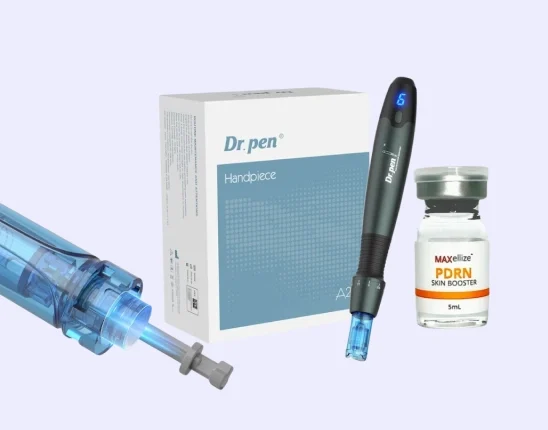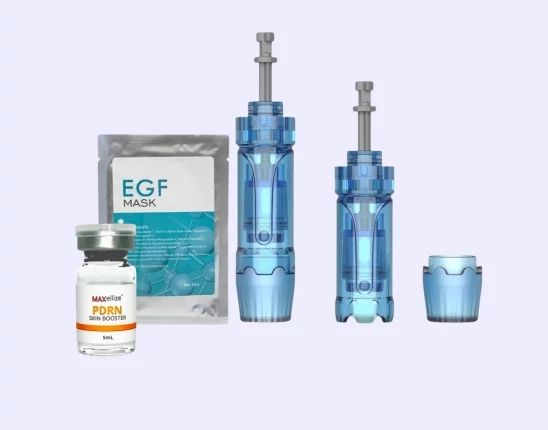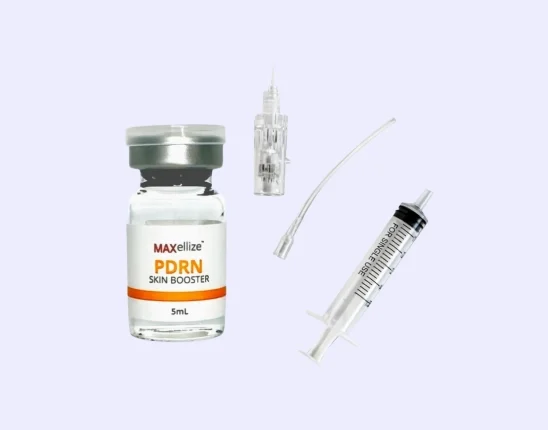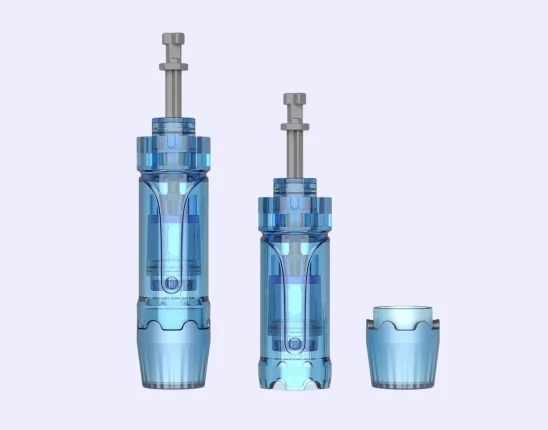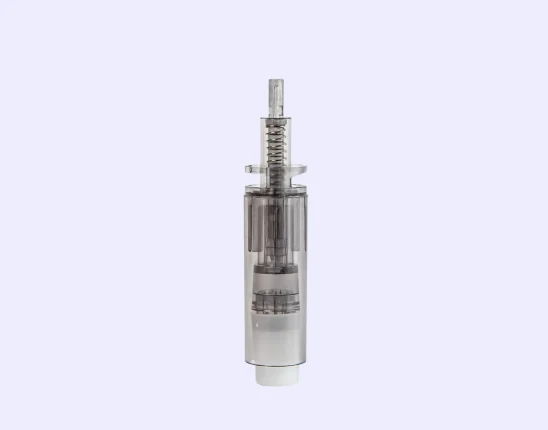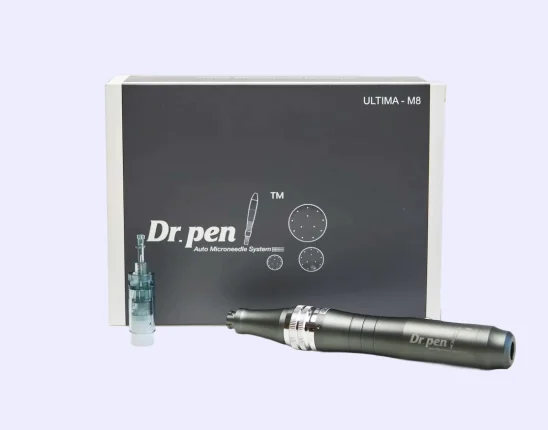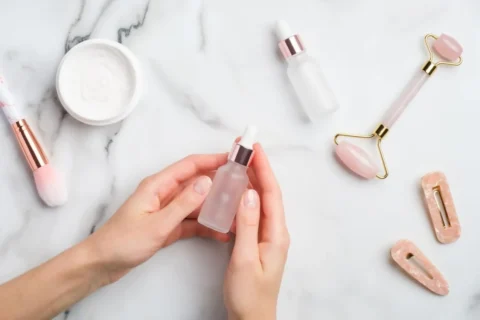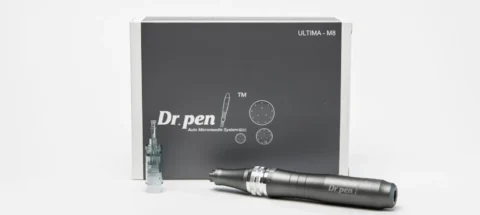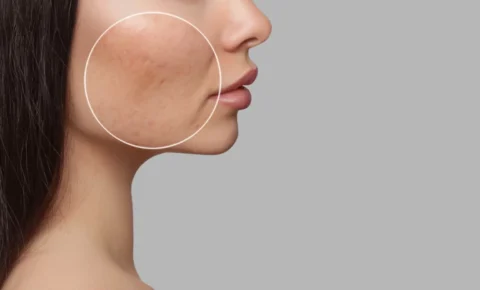Microneedling and Ultherapy are two cosmetic procedures that can address wrinkles in various stages. However, these two can provide very different results depending on the severity of wrinkles and time you have to develop results. It’s best to discuss with your dermatologist which solution is best for your skin, but here’s what you can expect between microneedling vs. ultherapy when it comes to treating wrinkles.
So which has better benefits for facial wrinkles? Microneedling and Ultherapy can both treat static wrinkles like those across the cheeks or in the corners of the mouth, but not dynamic wrinkles like crow’s feet and laugh lines. Microneedling when paired with Botox injections smoothens dynamic wrinkles. Microneedling is minimally invasive since it punctures the skin, while Ultherapy is non-invasive, but it reaches deep into the skin’s layers.

Get Everything You Need for Your Microneedling Pen and More at 20% off Your First Order with Code “20OFF”!
The Microneedling Pen treatment requires only the best equipment to deliver treatments and results your patients will love. Get your best Microneedling Pen equipment and more at FACE Med Store today!
You can create an account here.
Microneedling vs. Ultherapy
Microneedling and Ultherapy are great options for cosmetic treatments to use to reduce fine lines and wrinkles. They’re both similar in the way they use your body’s natural production of collagen to nourish your skin. When it comes to wrinkles, collagen is useful as it can give your skin its elasticity back, promoting skin rejuvenation by making your skin firmer and tighter.
Pros and Cons
| Microneedling | Ultherapy |
| Pros | |
| Available in multiple needle lengths. Small needle length is enough to trigger collagen stimulation, good for fine lines. For more severe wrinkles, longer needles are necessary. Generally less painful than Ultherapy. Although microneedling involves puncturing your skin, the needles are sharp and thin, so you can barely feel it. It is more painful if you do it on your ownl. In comparison, Ultherapy subjects you to heat from ultrasound waves, which can be uncomfortable. Can treat additional skin concerns. Aside from wrinkles, microneedling can treat different skin issues, including acne scars, microneedling can also treat scarring, large pores, stretch marks, sun damage, age spots, and more. | Non-invasive procedure with the deepest reach. Ultherapy uses ultrasound waves to reach the deeper part of the skin and muscles. Microneedling requires puncturing the skin to trigger your skin’s trauma response and produce more collagen, which leaves your skin vulnerable to scarring and infections if mishandled. Less sessions needed for longer results. You only need one or two Ultherapy sessions to reduce the signs of wrinkles for up to 12 months, though results can vary. No downtime. You may see reddish skin, swelling, and tenderness after an Ultherapy session, but this can subside after a few days. This is very minimal, and you can proceed with your daily activities, unlike microneedling, where certain use of skincare products and certain day-to-day activities are discouraged for the first few days and/or weeks of the procedure. |
| Cons | |
| Slower results. It can take weeks to see visible changes in your skin. Prone to bacterial infections. The punctures can be susceptible to infection, especially if you’re microneedling at home. This is why microneedling is not suitable for those with skin conditions like acne or eczema. Requires multiple sessions. Microneedling needs multiple sessions to maintain and improve the effects of the treatment. | More expensive than microneedling. Microneedling on its own can cost between $200 to $700 per session. In comparison, Ultherapy can cost an average of $1802 per session. May not be effective for severe sagging. Ultherapy may not be effective for severe wrinkles, loose skin, and skin sagging, and it may be more practical to undergo plastic surgery to treat it. Not available in all cosmetic clinics. Ultherapy should be done by a trained professional, so not all clinics may offer this. |
What to Expect from Microneedling
Should you choose to undergo microneedling, you can opt to do it by yourself at home or in a clinic done by a professional. If you’re looking to treat wrinkles effectively, this will require longer needles to reach into the deeper skin layers. It’s not recommended that non-medical practitioners do microneedling at home with needles longer than 2 millimeters, as the risk of permanent scarring, skin damage, and bacterial infection is higher.
During the procedure, your doctor will first disinfect the treatment area to prevent bacterial infection. They may also use a numbing cream if they will be using longer needles. They will then use a microneedling tool to puncture microchannels into your skin. This will take around 30 minutes to cover your whole face. Afterwards, they will apply a serum that can seep into these microchannel.
Microneedling requires no downtime for sessions that use smaller needles, but it needs minimal downtime for longer needles. You may take over-the-counter painkillers to subdue the stinging feeling after your sessions. During your recovery time, you can continue your skincare routine, but you should avoid using harsh skincare products and products with active ingredients like salicylic acid, vitamin C, retinol, and hyaluronic acid. You should also practice applying sunscreen when going outside, as your skin is more sensitive to UV ray exposure.
It can take weeks before you see the results of your microneedling treatment. However, if you want to maintain or enhance the results, you will need to schedule more microneedling sessions. For dynamic wrinkles, these may resurface because you naturally move your muscles, so you may need to schedule another microneedling session months after treatment.
What to Expect from Ultherapy
At the start of the procedure, your doctor will first clean the treatment area and apply an ultrasound gel. They will then use an Ultherapy device to deliver ultrasound waves to the targeted area. During this time, you will feel varying levels of heat throughout the process – that’s the ultrasound energy heating your skin and muscles to promote collagen growth. Treatment time can take up to an hour and a half, though it depends on which parts you are treating.
Following the procedure, your treated skin may be reddish and prone to swelling and tenderness. This is normal and will go back to normal after a few days. No downtime is required, and you can resume your usual activities after your treatment.
You should begin to notice the effects of Ultherapy after the swelling subsides. This can last for up to three months, though this can vary depending on your body’s ability to produce more collagen.
Microneedling, Ultherapy, and Wrinkles

Microneedling and Ultherapy are different cosmetic procedures, but they tackle different types of wrinkles in a similar way that boosts your body’s collagen production. To further understand the effectiveness of these two procedures against wrinkles, you have to understand why wrinkles develop on your face and how far each treatment can go on its own.
Why Do Wrinkles Form on Your Face?
Wrinkles are inevitable as you grow older. Factors like age can’t be stopped, but factors like sun exposure, smoking habits, repeated facial expressions, and lifestyle can affect the severity of how visible your wrinkles will be – even as a young adult.
There are two types of wrinkles that can develop on your face: dynamic wrinkles and static wrinkles. These form on your face through different ways.
Dynamic wrinkles develop because of facial muscles that are attached to your skin. Every time your muscle contracts, your skin moves with it and creates a crease in your skin. When this movement is repeated over time, it develops a line in your skin that eventually becomes your wrinkle. Examples of dynamic wrinkles include crow’s feet at the corners of your eyes that develop from smiling and squinting, or frown lines in between your brows that crease when you frown.
Static wrinkles, on the other hand, are caused by UV damage from sun exposure, age, genetics, poor skin health, and unhealthy habits like smoking. When you’re young, your body produces enough collagen, elastin, and new skin cells to prevent these factors from causing wrinkling. As you grow older, however, your skin produces less collagen and creates new skin cells at a slower pace, making it less taut and resulting in wrinkles.
Boost Your Patient’s Skin With A Peptide-rich Face Mask. Stock Up and Get 20% OFF Your First Order With CODE “20OFF”.
Enrich your patients’ skincare routine with a face mask that soothes and reduces wrinkles. Give your patients a skin boost with our carefully-formulated EGF Mask.
You can create an account here.
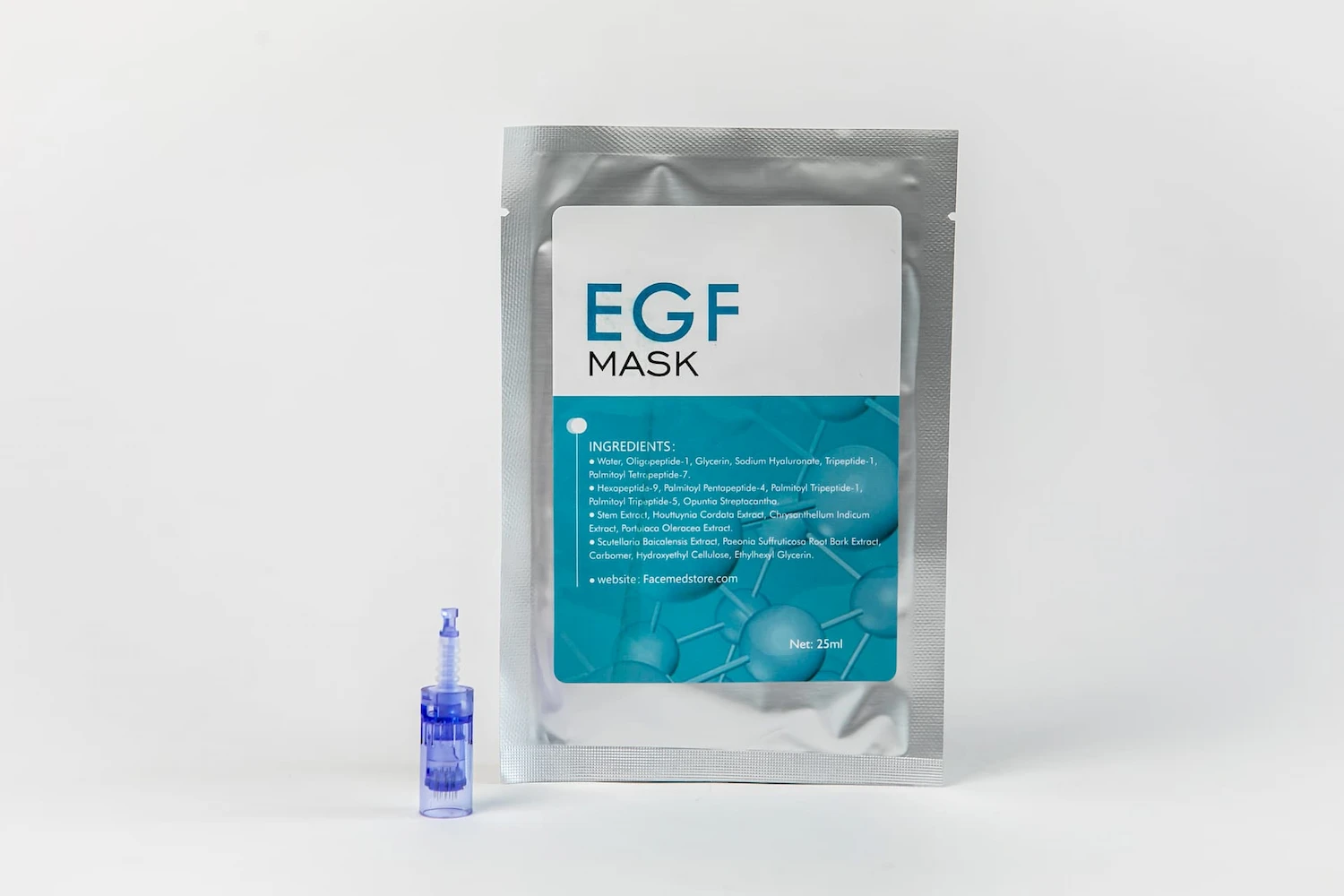
How Both Procedures Treat Wrinkles
Both treat wrinkles using your body’s natural collagen production, but this is triggered in different ways.
Through microneedling, thin needles puncture your skin and trigger your body’s skin trauma response. This results in the additional production of collagen and elastin to repair your damaged skin tissue and replace it with newer skin cells. These new skin cells, combined with the additional collagen, can help your skin become firmer and more elastic, which can stretch your skin back and reduce the severity of wrinkles.
Ultherapy, on the other hand, uses ultrasound technology to heat the layers of skin and muscle through ultrasound energy to promote collagen regeneration. By stimulating collagen and elastic tissue, your skin becomes firmer and less likely to sag, reducing the appearance of wrinkles.
Can Both Procedures Treat All Types of Wrinkles?
Both microneedling and Ultherapy can help reduce subtle and deep wrinkles. While both can effectively treat static wrinkles due to age and external factors, these alone might not be best for dynamic wrinkles, as facial muscles will continue to deepen the crease and create wrinkles.
Microneedling is a slow process. It takes multiple sessions to show visible results. This means the effects of microneedling dynamic wrinkles can be reversed before the next session can roll in. Ultherapy, on the other hand, promotes collagen production that can tighten skin and reduce the appearance of wrinkles. However, it cannot stop dynamic wrinkles from developing due to repeated facial expressions and movements.
To best treat dynamic wrinkles with microneedling or Ultherapy, your doctor may recommend pairing microneedling sessions with Botox injections, since this can prevent your facial muscles from forming deep creases on the skin.
Treat Wrinkles with FACE Med Store
-
 Dr. Pen A20 Replacement Needles
Dr. Pen A20 Replacement Needles -
 Dr. Pen A20 – FDA CLEARED – professional grade
Dr. Pen A20 – FDA CLEARED – professional grade -
 Dr. Pen M8 Replacement Needles – Bag of 10 PLUS 10 Maxellize PDRN Skin Booster and 10 EGF masks
Dr. Pen M8 Replacement Needles – Bag of 10 PLUS 10 Maxellize PDRN Skin Booster and 10 EGF masks -
 Dr. Pen A9 Ultima Pro Microneedling Pen Plus 5-Maxellize PDRN Skin Booster and 10 EGF Masks
Dr. Pen A9 Ultima Pro Microneedling Pen Plus 5-Maxellize PDRN Skin Booster and 10 EGF Masks -
 Microneedling Pen 2.0 Replacement Kit bundled with Maxellize PDRN Skin Booster
Microneedling Pen 2.0 Replacement Kit bundled with Maxellize PDRN Skin Booster -
 Dr. Pen A9 Replacement Needles – Bag of 10- 18 Pin Needles
Dr. Pen A9 Replacement Needles – Bag of 10- 18 Pin Needles -
 TinySoft – NanoSoft Microneedles – 34g – 3 pin – box of 30
TinySoft – NanoSoft Microneedles – 34g – 3 pin – box of 30 -
 Dr. Pen A7 replacement needles – 12 pin – 10 Pack
Dr. Pen A7 replacement needles – 12 pin – 10 Pack -
 Dr. Pen M8 plus 10-16 pin needles
Dr. Pen M8 plus 10-16 pin needles
Both microneedling and Ultherapy are effective treatments for wrinkles by boosting your body’s collagen production, which helps create firmer, elastic skin that’s less likely to sag. Both cannot treat all types of wrinkles on their own, so it’s best to discuss with your doctor the kind of wrinkles you have, in order to know which the better solution is between the two. Your doctor can also recommend additional cosmetic treatments you might need to enhance your appearance.
FACE Med Store is the go-to supplier for medical supplies and tools for cosmetic clinics and aesthetic centers. We partner with medical professionals and provide quality materials at competitive prices that can smoothen operations, drive profits, and boost customer satisfaction.
Visit our online store today.
